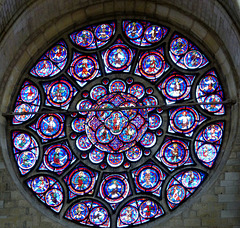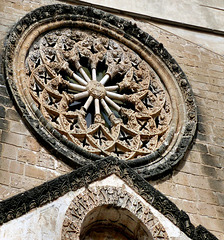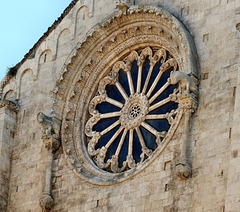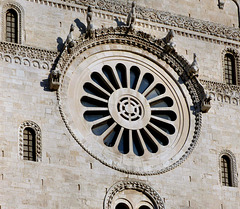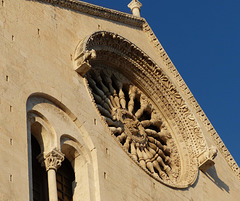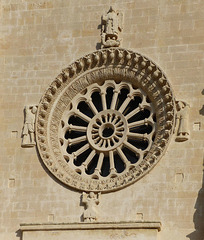
Rose windows
Laon - Cathedral
| |
|
|
|
In Laon, placed on a ridge and overlooking the flat Picardy plain, St. Remi founded a bishopric in 487. Laon was a very important place in the kingdom of the Franks.
A Carolingian cathedral, consecrated in 800 in the presence of Charlemagne, existed here. The Carolingian structure got replaced two centuries later by a Romanesque structure, consecrated in 1071.
This cathedral was torched by the citizens during the Easter Insurrection on 25 April 1112. Bishop Waldric (aka "Gaudry"), who had served as Lord Chancellor and Lord Keeper of England, from 1103 to 1107 (and described as greedy and very violent) was killed during the uproar. The cathedral got repaired, but in the end demolished to give room for the present cathedral.
The construction began about 1160. The nave was completed after 1205. The "Cathédrale Notre-Dame de Laon", towering over the town, is a wonderful, early example of the Gothic style that developed in Northern France.
Stained glass can be found in nearly all Gothic cathedrals in France. Techniques for the production of colored glass and for the manufacturing of large windows out of it, was fast developing during the 11 th century. This was a high-tech-industry with wonderful products. like the large rose-window of the choir.
Montréal - Notre-Dame-de-l’Assomption
| |
|
Today Montréal is a small village (pop. 200), but here was already a fortified settlement, when the Normans raided the area and pillaged the place in 888. From the 11th century on here was a castle. Anseric I, Seigneur de Montréal, obviously listened to Bernard de Clairvaux, who preached the Second Crusade at near Vezelay in 1146.
Returning home from the crusade Anseric I founded a collegiate and commissioned the erection of the collegiate church, seen here. The church was completed around 1170 by Anseric II. The convent existed upto the French Revolution.
During the Revolution, the tympanum got destroyed and when for a year, the church served as a "Temple de la Raison". The according inscription is fading over the doors, where once the tympanum was. Today church serves the parish. Eugène Viollet-le-Duc was impressed by the church, built during the transition from Romanesque to Gothic style, and cared for the restauration in the first half of the 19th century.
He restored the nice portal. The polylobe arches seem influenced by Moorish architecture, a style, that was more common in Southern France. I learned, that the rose window, seen here, is one of the oldest of its kind in the whole of France.
Verona - Basilica di San Zeno
| |
|
Already Theodoric the Great, King of the Ostrogoths, may have funded a church, erected over the tomb of Saint Zeno, who, following the legends, was born in Mauretania and died around 380 in Verona.
The erection of the present church began in the 9th century. Soon after San Zeno´s relics were translated into the new church. At that time Charlemagne´s son Pepin (aka "Pepin of Italy") resided in Verona and a large Benedictine monastery grew all around the church
When the Magyars invaded Italy in the early 10th century, the church got severely damaged, but the relics were not harmed, as they had been taken out and were hidden. In 967, a new church was built with the patronage of Otto I.
On January 3, 1117, the church was damaged by an earthquake, that ruined so many buildings in Northern Italy. The church was restored and got enlarged in 1138.
The façade is striking! It was created in two different stages. The portico and the portal were carved before 1138 by Niccolò (see "Duomo de Verona") and his school. During the second half of the 12th century Master Guglielmo ("Gugliemus") completed the facade.
This rose window, in the shape of a Wheel of Fortune, is one earliest examples a structure. The outer rim of the window is decorated by figures representing the vacillations of human life.
Assisi - Cattedrale di San Rufino
| |
|
|
Assisi is located on a steep slope (accessible via escalators) and a site of many a pilgrimage. Even in winter it can be very crowded - and a day before, we had to turn back, as all parking lots in the valley below were full. A day later, in heavy rain, we tried it again - and were in luck.
This "Cattedrale di San Rufino" of today is the third church on this spot. They had been built over the tomb of Saint Rufinus, Bishop of Assisi, martyred in the 3rd century.
The construction of the cathedral was started in 1134. When in 1228 Pope Gregory IX was in Assisi for the canonization of Saint Francis, he consecrated the high altar of the cathedral, that was finally completed in 1253.
Of course during the long time of construction, the church was in use already. Saint Francis was baptized here in 1182, Saint Clare in 1193.
The Romanesque façade of the Assisi-Cathedral is one of the richest in Umbria.
There are three rose windows here. That one in the center - seen here - is the largest and the most ornate. The window is supported by three atlantes. They are standing on mythical beasts (on the left a griffin).
In the four spandrels around the rose window are the four animal symbols of the four evangelists.
Spoleto - Duomo di Spoleto
| |
|
|
The site, now occupied by the Duomo di Spoleto (aka "Cattedrale di Santa Maria Assunta"), was probably the place of an episcopal complex already in paleo-Christian times. In 956 here was the church "Santa Maria del Vescovado", that got replaced by another in 1067, dedicated to San Primiano. This church got destroyed by Barbarossa's troops, when they devastated Spoleto.
The construction of the Spoleto Cathedral begun before 1175 and was completed in 1227. The facade got enlarged soon after. Here is the large central rose window, created end of the 12th century.
Embrun - Cathédrale Notre-Dame-du-Réal
| |
|
|
Since 365, when Saint Marcellin became the first bishop here, a cathedral existed in Embrun. Saint Gregory of Tours wrote about a "basilica mirabilis" built over the tombs of Saints Nazarius and Celsus. After the Lombards had sacked Embrun end of the 6th century, Charlemagne funded the erection of a new cathedral. In the 10th century the Sarazens raided the area - and again looted the town (and killed the bishop).
The cathedral of today was built on foundations of Charlemagne´s basilica between 1170 and 1220.
Compared to the northern "Port Real", the Romanesque main portal is pretty plain. The huge rose window above dates to the 15th century.
Nuremberg - St. Lorenz
| |
|
|
|
The construction St. Lorenz started around 1250, replacing a smaller Romanesque church here. At the same time St. Sebaldus, another great church in Nuremberg was under construction - only 300 meters east. That probably caused a kind of rivalry.
St. Lorenz was completed ~ 1390, but - following St. Sebaldus - already a decade later alterations started. The side aisles got demolished and were replaced by wider ones. The erection of the Gothic hall-chancel was done 1439 - 1477. Since 1525 St. Lorenz is a (Evangelical) Lutheran parish church. Only 8 years after Martin Luther nailed his Ninety-five Theses to the door of the Schlosskirche in Wittenberg.
When carpet bombings during World War II destroyed most of the old town of Nuremberg, St. Lorenz got badly damaged. The rebuilding started end of the 1940s.
The rose window of the western facade is 9 meters in diameter.
lorenzkirche.de/
Palermo - Sant'Agostino
| |
|
|
Sicily, the largest of all Mediterranean islands, has a long history, that starts around 8000 BC, but later there were Phoenician, Carthaginian, Greek and Roman periods. After the Roman Empire had fallen apart the Vandals tried to take over the island but failed. Finally, the Ostrogoths took possession.
Mid of the 6th century Sicily was conquered by troops of the Byzantine Empire and became a Byzantine province. After the advent of Islam, Sicily got attacked by the Arab forces. Raids seeking loot continued until the mid-8th century.
A Muslim army was sent to the island in 827 but met with much resistance. So it took a century to conquer it and even later revolts constantly occurred
In 1038 the Byzantines invaded the island supported by their Norman mercenaries, led by Roger. In 1072, after the siege of Palermo, most of Sicily was under Norman control. Roger´s son Roger II raised the status of the island to a kingdom in 1130. During this period, the Kingdom of Sicily was prosperous and powerful,
The court of Roger II became melting out of culture, both from Europe and the Middle East. This attracted scholars, scientists, artists, and artisans. Muslims, Jews, Greeks, Lombards, and Normans worked together and created some extraordinary buildings.
In 1186 the last descendant of Roger, Constance of Sicily married Emperor Henry VI, the second son of Frederick Barbarossa. So the crown of Sicily was passed on to the Hohenstaufen Dynasty. Frederick II, the only son of Constance, was crowned King of Sicily at the age of four in 1198. He became "Stupor Mundi", one of the greatest and most cultured men of the Middle Ages.
Palermo, founded in 734 BC by the Phoenicians, became a possession of Carthage. The town later became part of the Roman Empire. From 831 to 1072 the city was under Arab rule. Following the Norman conquest, Palermo became the capital of a new Kingdom of Sicily and the capital of the Holy Roman Empire under Emperor Frederick II and King Conrad IV.
Today Palermo is a bustling city with a population of about 700.000 plus - many many tourists.
Sant'Agostino was built end of the 13th century in early Gothic style, when the Capetian House of Anjou was in power in Palermo. It replaced on older Romanesque church and still is the church of the Order of Saint Augustine. It got remodeled, renovated and "modernized" a couple of times over the centuries, but the wonderfuld rose window survived the times.
Bitonto - Concattedrale di Bitonto
| |
|
|
Bitonto, today a city of a population of about 55000, was probably founded by Greek settlers. Traces of a city wall dating to the 5th and 4th century BC were found. Legends tell that the name Bitonto is connected to an Illyrian king named Botone. Later "Civitas Butuntinenses" became a self-governing Roman municipium,
A Paleochristian basilica existed very early. During the 9th century, Bitonto successfully withstood a Saracen raid but got destroyed by Byzantine troops in 975. The Normans took over Apulia. In the 11th and 12th century. Under the rule of the Normans of Roger II of Sicily, William I of Sicily (aka William the Wicked) and William II of Sicily (aka William the Good), the city prospered and got new walls.
In 1227, Bitonto was the scene of ex-communication of Frederick II accused by pope Gregory IX of having come to terms with the sultan al-Malik al-Kamil.
-
The Bitonto Cathedral, dedicated to San Valentino, was erected 1175/1200 in the centre of the city. The construction was probably influenced by the "Basilica of San Nicola" in Bari and was done in the typical "Apulian Romanesque" style.
It is proven that the bishopric existed in 1089, though the crypt of the cathedral has remains of a 5th-century church.
There are three portals. The central one has a double archivolt, adorned with animal and vegetable figures, on which stands an overarch, richly carved with acanthus leaves and surmounted by a pelican, a bird that symbolizes the generosity of the Church. The overarch is supported by a pair of stone griffins holding prey between the claws. The whole is in turn supported by columns resting on lions.
The rose window above is the oldest in Apulia.
Giovinazzo - Concattedrale di Santa Maria Assunta
| |
|
|
The area around Giovinazzo had settlements already in Greek times, a place named Natolium was rebuilt in Roman times after it had been completely destroyed during the Punic wars. In the 7th century, it was held by the Lombards, then by the Byzantines, before the Norman conquest started and it developed to a Norman castrum under Robert the Guiscard.
The Concattedrale di Santa Maria Assunta stands on the site of an older church known as "Santa Maria de Episcopio". The cathedral was erected between 1125 and 118 and has this complex Romanesque rose-window.
Bovino - Concattedrale di Santa Maria Assunta
| |
|
|
Bovino, named Vibinum by the Romans, has a long history. After the end of the Roman empire, it was conquered by the Lombards but got destroyed in 663 during the war with the Byzantines, who requonquered and rebuilt it from 876 on. During the Norman conquest of southern Italy in the 11th centiry Bovino was one of the last strongholds of the Byzantines.
Upto 1986 Bovino was the see of a Bishop, so it is claimed, that already in the 7th century a cathedral may have existed here. This ancient cathedral was restored or rebuilt in he 10th century and again 1188 and 1231.
The cathedral was destroyed by an earthquake in 1930 and was rebuilt with the exception of the Baroque additions.
The façade dates back to the reconstruction carried out between the 12th and 13th centuries. I had learned from my literature about an inscription naming the master Zanus Gallicus and the year 1231. The rose-window over the central door was probably more complex at that time, but over the centuries, the inner parts got lost.
Bari - Cattedrale di San Sabino
| |
|
|
Bari was an early settlement and passed under Roman rule in the 3rd century BC. It developed strategic significance as the point of junction between the coast road and the Via Traiana and as a port for eastward trade. The first bishop of Bari was Gervasius who is known from the Council of Sardica in 347.
After the decline of the Roman Empire, the town was devasted and taken by Alaric´s Visigothic troops, then was under Lombardian rule, before the Byzantines took over. In 755 it was conquered by Pepin the Short (Charlemagne´s father) and from 847 on it was an Islamic Emirate. The Byzantine fleet returned in 871 and since 885 Bari ws the residence of the local Byzantine governor.
Following a three-year siege, Bari was captured by Robert Guiscard in 1071. After the relics of Saint Nicholas, which were surreptitiously brought from Myra in Lycia (Byzantine territory), arrived in Bari, the Basilica di San Nicola was founded in 1087. This attracted pilgrims, whose encouragement and care became central to the economy of Bari. Pope Urban II consecrated the Basilica in 1089. In 1096 a crusader army embarked in the port of Bari for the First Crusade.
After the murder of archbishop Griso in 1117 a civil war broke our and the control was seized by Grimoald Alferanites, a native Lombard, in opposition to the Normans. He later did homage to Roger II of Sicily, but rebelled and was defeated in 1132.
The Castello Normanno-Svevo (aka "Castello di Bari") was probably built around 1132 by Norman King Roger II. When in 1155 the Baresi rebelled against the Normans, the castle got destroyed, so as a retaliatory action, William I of Sicily (aka William the Wicked") had the city destroyed except for the cathedral and the Basilica of St. Nicola.
Bari recovered and had its heydays under Frederick II. When he returned from his crusade after 1229, the city gates were locked so he had to use force to gain entry. Therefore, he probably had the fort built in 1233 to keep the city in check. On the other hand, he granted the city generous trade privileges and left it the leading role in the region.
-
The construction of the "Cattedrale di San Sabino" (aka "Bari Cathedral" started around 1170 on. The cathedral is the seat of the Archbishop of Bari-Bitonto. It is dedicated to Saint Sabinus, a bishop of Canosa, whose relics were brought here in the 9th century.
It was erected on the site of the ruins of the Imperial Byzantine cathedral, destroyed in 1156 by William I of Sicily with the rest of the city.
For the reconstruction of the cathedral materials from the preceding church and other destroyed buildings got reused. During the 18th century the façade, the nave and aisles and the crypt were refurbished in Baroque style. The building later underwent a series of refurbishments, demolitions and extensions. The original Romanesque appearance of the interior was restored in the 1950s.
Around the semicircle above the façade´s rose window sit fantastic, mythic and very evil monsters and beasts look down to the tourists. Some of them have the prey already between their claws.
Bari - Cattedrale di San Sabino
| |
|
|
|
Bari was an early settlement and passed under Roman rule in the 3rd century BC. It developed strategic significance as the point of junction between the coast road and the Via Traiana and as a port for eastward trade. The first bishop of Bari was Gervasius who is known from the Council of Sardica in 347.
After the decline of the Roman Empire, the town was devasted and taken by Alaric´s Visigothic troops, then was under Lombardian rule, before the Byzantines took over. In 755 it was conquered by Pepin the Short (Charlemagne´s father) and from 847 on it was an Islamic Emirate. The Byzantine fleet returned in 871 and since 885 Bari ws the residence of the local Byzantine governor.
Following a three-year siege, Bari was captured by Robert Guiscard in 1071. After the relics of Saint Nicholas, which were surreptitiously brought from Myra in Lycia (Byzantine territory), arrived in Bari, the Basilica di San Nicola was founded in 1087. This attracted pilgrims, whose encouragement and care became central to the economy of Bari. Pope Urban II consecrated the Basilica in 1089. In 1096 a crusader army embarked in the port of Bari for the First Crusade.
After the murder of archbishop Griso in 1117 a civil war broke our and the control was seized by Grimoald Alferanites, a native Lombard, in opposition to the Normans. He later did homage to Roger II of Sicily, but rebelled and was defeated in 1132.
The Castello Normanno-Svevo (aka "Castello di Bari") was probably built around 1132 by Norman King Roger II. When in 1155 the Baresi rebelled against the Normans, the castle got destroyed, so as a retaliatory action, William I of Sicily (aka William the Wicked") had the city destroyed except for the cathedral and the Basilica of St. Nicola.
Bari recovered and had its heydays under Frederick II. When he returned from his crusade after 1229, the city gates were locked so he had to use force to gain entry. Therefore, he probably had the fort built in 1233 to keep the city in check. On the other hand, he granted the city generous trade privileges and left it the leading role in the region.
-
The construction of the "Cattedrale di San Sabino" (aka "Bari Cathedral" started around 1170 on. The cathedral is the seat of the Archbishop of Bari-Bitonto. It is dedicated to Saint Sabinus, a bishop of Canosa, whose relics were brought here in the 9th century.
It was erected on the site of the ruins of the Imperial Byzantine cathedral, destroyed in 1156 by William I of Sicily with the rest of the city.
For the reconstruction of the cathedral materials from the preceding church and other destroyed buildings got reused. During the 18th century the façade, the nave and aisles and the crypt were refurbished in Baroque style. The building later underwent a series of refurbishments, demolitions and extensions.
As a gate was open in the late afternoon, I could enter the yard and take photos of the transept. Two persons holding bulls (?) flank the fantastic rose window.
Matera - Cattedrale di Matera
| |
|
|
The original settlement of Matera lies in two canyons carved by the Gravina River. This area, the Sassi di Matera, is a complex of cave dwellings carved into the ancient river canyon. The settlement is divided into the districts of Sasso Barisano and Sasso Caveoso.
The cave settlements in the area are an exceptional example in the Mediterranean area. Inhabited since the Neolithic Age, Matera can be considered one of the oldest cities in the world.
According to Greek, Roman, Langobard and Byzantine history, which Matera shares with all of southern Italy, Saracens devastated the place in 938. It came under Norman rule in 1043, became a royal seat and thus achieved considerable wealth. This bloom continued under the subsequent regiments of the Staufer and Anjou, in 1270 the cathedral of Matera was completed.
Already by the late 1800s, Matera's cave dwellings became noted for intractable poverty, poor sanitation, meager working conditions, and rampant disease. In 1948, when the city was hit by malaria, 15,000 people lived in 3,300 rooms. From the 1950s on the residents were relocated to newly built apartment blocks. Since the Sassi are now a museum town, tourism is also becoming increasingly important.
Known as la città sotterranea ("the underground city"), the Sassi and the park of the Rupestrian Churches were named a UNESCO World Heritage Site in 1993. In 2019, Matera was declared a European Capital of Culture.
Today Matera has a population of about 60.000, who live in the city "above" the sassi.
The Matera Cathedral (Cattedrale della Madonna della Bruna e di Sant'Eustachio) was built on the highest point between the two sassi, on the site of the ancient Church of Saint Eustace. The erection in Apulian Romanesque style started in 1230 at the behest of Emperor Frederick II of Swabia, Holy Roman Emperor and Count of Matera. A few years earlier Pope Innocent III had raised Matera to the rank of archdiocese in union with Acerenza. It was completed in 1270.
Unlike the interior which has undergone several transformations over time, the exterior retains its original form almost intact.
The façade is dominated by the rose window, surmounted by the archangel Michael, killing the evil dragon. Two male figures on the sides and another at the bottom that acts as an atlas.
Lecce - Basilica di Santa Croce
| |
|
|
A legend tells, that a city called Sybar existed at the time of the Trojan War. It was conquered by the Romans in the 3rd century BC, receiving the new name of Lupiae.
After the fall of the Western Roman Empire, Lecce was sacked by the Ostrogoth troops of king Totila. In 549 it was taken by Byzantium and remained part of the Eastern Roman Empire for five centuries, interrupted by brief invasions by the Saracens, Longobards, Hungarians and Slavs.
After the Norman conquest in the 11th century, Lecce regained commercial and political importance, flourishing in the subsequent Hohenstaufen and Angevine rule. From the 15th century, Lecce was one of the most important cities of southern Italy, and, starting in 1630, it developed into a centre of Baroque architecture. This was made possible by the soft tuff stone found in the area, perfect for that architecture.
-
Walter VI, Count of Brienne (and Lecce), founded a monastery here in 1352 for the Celestines, a kind of branch of the Benedictines.
The monastery and the "Basilica di Santa Croce" were completely rebuilt in Baroque style from 1549 on. Where the church is now the Jewish community had lived until 1510, when the Jews got ousted.
The construction of the church took about two centuries. In 1582 the lower part of the facade had been finished, the dome was completed in 1590. The portals were added from 1606 on. The church was completed by Cesare Penna and Giuseppe Zimbalo.
The church has a richly decorated façade, with animals, grotesque figures and vegetables, and has a large rose window. The main portal has a pair of Corinthian columns and the coats of arms of Philip III of Spain, Mary of Enghien and Walter VI of Brienne, while on the side portals are those of the Celestines. The atlantes may represent the Turk prisoners made at the Battle of Lepanto (1571).
Altamura - Cattedrale di Santa Maria Assunta
| |
|
|
The area around the modern Altamura (pop 70.000) was inhabited in early times. There are Bronze Age tumuli and between the 6th and the 3rd century BC a massive line of megalithic walls was erected. This (later Roman) city was inhabited until the 10th century when it was reportedly looted by Saracens. A couple of centuries after Altamura was reportedly looted by the Saracens, it started to be inhabited again as Emperor Frederick II refounded the city (1232) and ordered the construction of the large Altamura Cathedral, which became one of the most venerated sanctuaries in Apulia.
Altamura was ruled by various feudal families, including the Orsini del Balzo and the Farnese (1538–1734), the latter responsible for the construction of numerous palaces and churches. In the past, Altamura also had a large castle, whose construction dated back to the 11th-13th century, which has been completely demolished.
Altamura Cathedral (Cattedrale di Santa Maria Assunta) was founded by Emperor Frederick II in 1232. In 1248, under pressure from Frederick, Pope Innocent IV declared Altamura exempt from the jurisdiction of the bishop of Bari, making it a "palatine church", that is the equivalent of a palace chapel. After heavy damage caused by an earthquake in 1316, it was renovated by Robert of Anjou.
Major changes were made to the cathedral in 1534, including switching the front and back around! The cathedral's main facade originally faced west but it now faces east. The Gothic window of the apse, which had been in place since 1232, was moved to the left side to make room for the large rose window, that dominates the facade. The window is balanced on the shoulders of a tiny atlant.
Gravina in Puglia - Concattedrale di Santa Maria A…
| |
|
|
Gravina was populated already in Stone Age times, it was colonized by the Greeks during the colonization of Greater Greece. The Romans took over around 300 BC and the Via Appia, which linked Rome to Brindisi, passed through Gravina. After the fall of the Western Roman Empire it was ruled by Goths, Byzantines, Lombards and Saracens. The Normans arrived around 1000. The town was the site of a Norman countship in the Hauteville Kingdom of Sicily and in 1091 the construction of the Norman cathedral started.
Emperor Frederick II had a castle built nearby, that is meanwhile in ruins. From 1386 to 1816 (!) it was a fief of the Orsini family.Feudal oppression led to numerous riots, in particular from 1789 until the unification of Italy in 1861.
A cathedral was built here at the end of the 11th century by Umfrido d'Altavilla (aka Humphrey of Hauteville), Count of Apulia and Calabria.
This "Norman" church was destroyed in 1447-1456 by a fire followed by an earthquake. The present cathedral was rebuilt in the following thirty years following, in a Renaissance-Romanesque style. In the 17th and 18th century the church underwent some Baroque alterations inside. Today the church is presented as a synthesis of different architectural styles: the late Romanesque, the Renaissance and the Baroque.
The facade has this really intricate, wonderful rose window.
Gravina in Puglia - Concattedrale di Santa Maria A…
| |
|
Gravina was populated already in Stone Age times, it was colonized by the Greeks during the colonization of Greater Greece. The Romans took over around 300 BC and the Via Appia, which linked Rome to Brindisi, passed through Gravina. After the fall of the Western Roman Empire it was ruled by Goths, Byzantines, Lombards and Saracens. The Normans arrived around 1000. The town was the site of a Norman countship in the Hauteville Kingdom of Sicily and in 1091 the construction of the Norman cathedral started.
Emperor Frederick II had a castle built nearby, that is meanwhile in ruins. From 1386 to 1816 (!) it was a fief of the Orsini family.Feudal oppression led to numerous riots, in particular from 1789 until the unification of Italy in 1861.
A cathedral was built here at the end of the 11th century by Umfrido d'Altavilla (aka Humphrey of Hauteville), Count of Apulia and Calabria.
This "Norman" church was destroyed in 1447-1456 by a fire followed by an earthquake. The present cathedral was rebuilt in the following thirty years following, in a Renaissance-Romanesque style. In the 17th and 18th century the church underwent some Baroque alterations inside. Today the church is presented as a synthesis of different architectural styles: the late Romanesque, the Renaissance and the Baroque.
Obviously at some time after the earthquake the structure suffered from static stress, so that a buttress was added. This destroyed the rose window.
Jump to top
RSS feed- Latest items - Subscribe to the latest items added to this album
- ipernity © 2007-2024
- Help & Contact
|
Club news
|
About ipernity
|
History |
ipernity Club & Prices |
Guide of good conduct
Donate | Group guidelines | Privacy policy | Terms of use | Statutes | In memoria -
Facebook
Twitter

